BMW’s N55 inline-six engine is nothing short of an automotive legend.
Introduced in 2009, this turbocharged powerplant redefined what enthusiasts expected from a modern six-cylinder—delivering a seamless blend of performance, reliability, and cutting-edge technology.
While the N55 is often associated with flagship models, there exists a collection of lesser-known BMWs that harness its full potential in surprising ways.
This article uncovers ten hidden gems that truly showcase the magic of the N55, each offering a unique twist on BMW’s celebrated engineering.
Pontiac was on a roll in the 1960s. During the early part of the decade, specially trimmed models with buckets and (sometimes) consoles were becoming a thing, and Pontiac stepped up to the plate and created a special model of its own. Based on the Catalina, the newly christened Grand Prix two-door hardtop featured a distinctive inset grille, special trunklid trim, clean flanks, a standard 303-horsepower Trophy V8 with a four-barrel carburetor, buckets, a center console, and a tachometer. Needless to say, the new model was a rousing success. A fine example of the 1962 Pontiac Grand Prix is the focus of today’s AutoHunter Spotlight. Restored within the last four years at a reported cost of $100,000, it is powered by a 455 Tri-Power paired with a TH400 transmission. With a Midnight Blue metallic body complemented by a white painted top over a black interior, this personal-luxury Poncho comes from the selling dealer with build receipts, spare parts, the original 389, and a branded title.
Nineteen sixty-two was the year Pontiac instituted convertible-like styling for its two-door hardtops. The hardtop on this Grand Prix is white, which nicely contrasts with the deep blue body. Other features include a driver-side mirror, rocker moldings, LED headlights, chrome ornaments on the front fenders, and a front fender-mounted antenna. A set of 8-lug wheels are wrapped in 235/75 American Classic wide-whitewall tires.
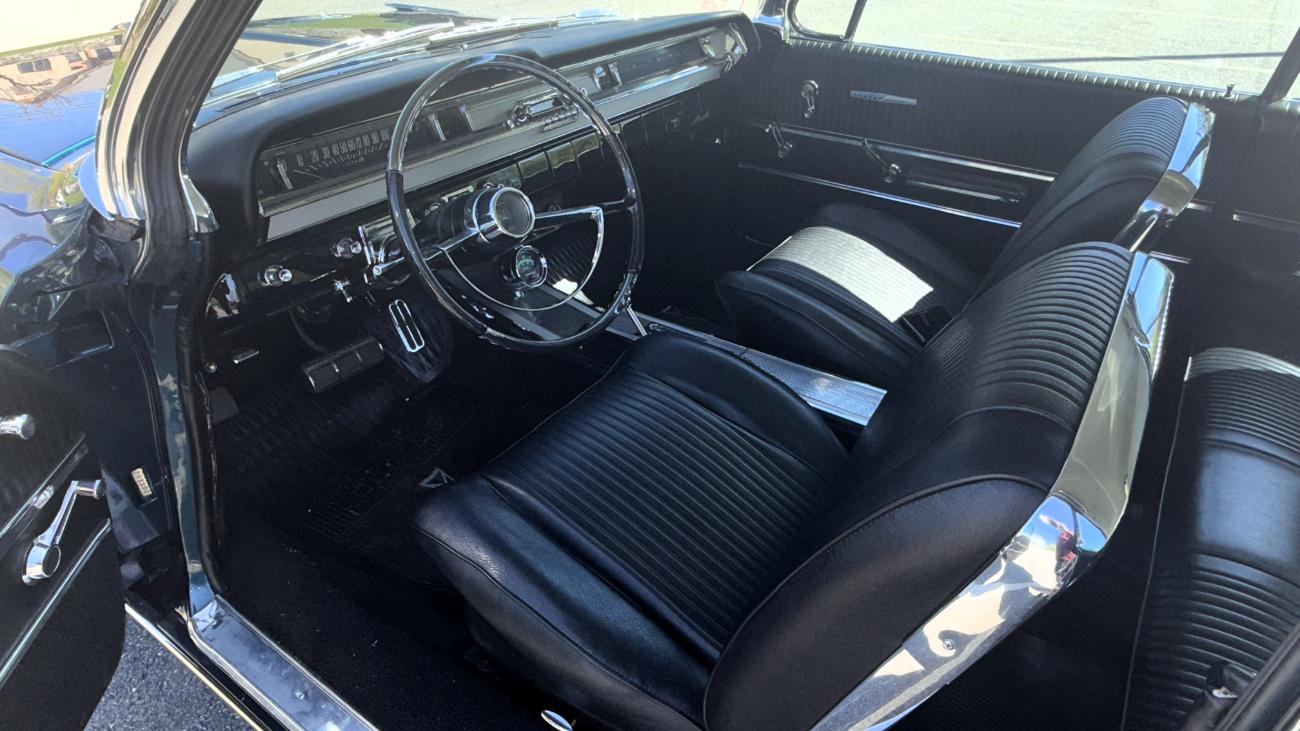
The black vinyl interior features front bucket seats with a center console. Other interior features include a push-button AM radio, clock, heater, an instrument panel pad, chrome pedal trim, and rubber floor mats.
Instrumentation includes a 120-mph speedometer, console-mounted 7,000-rpm tachometer, and fuel gauge. An aftermarket gauge cluster for the oil pressure, voltage, and coolant temperature is mounted underneath the dashboard. The odometer shows 60,344 miles, though the true mileage is unknown.
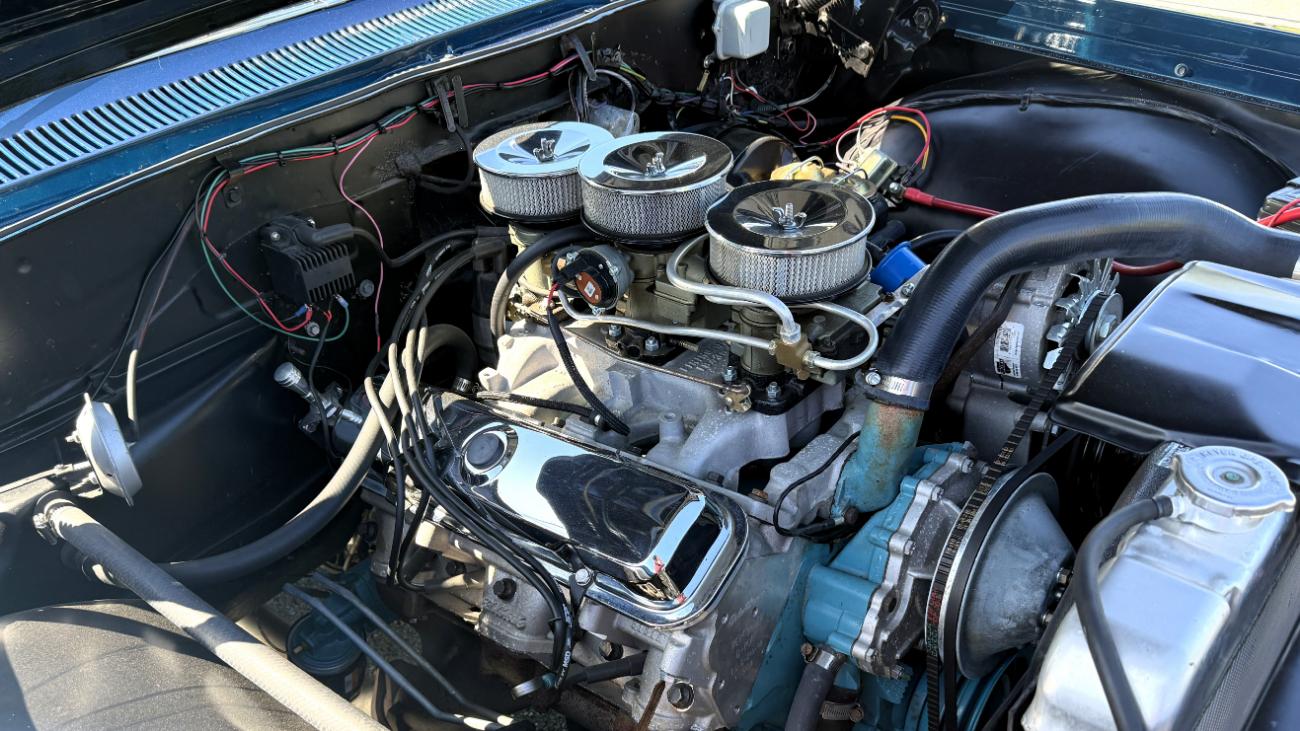
The rebuilt 455 (which has accrued less than 1,000 miles since being overhauled) features Tri-Power induction, Edelbrock Performer aluminum heads, roller rockers, and more. The engine is backed by a three-speed TH400 automatic.

The undercarriage features a custom driveshaft leading to a limited-slip differential. Other features include power brakes, newer springs and shackles, and a dual exhaust system.
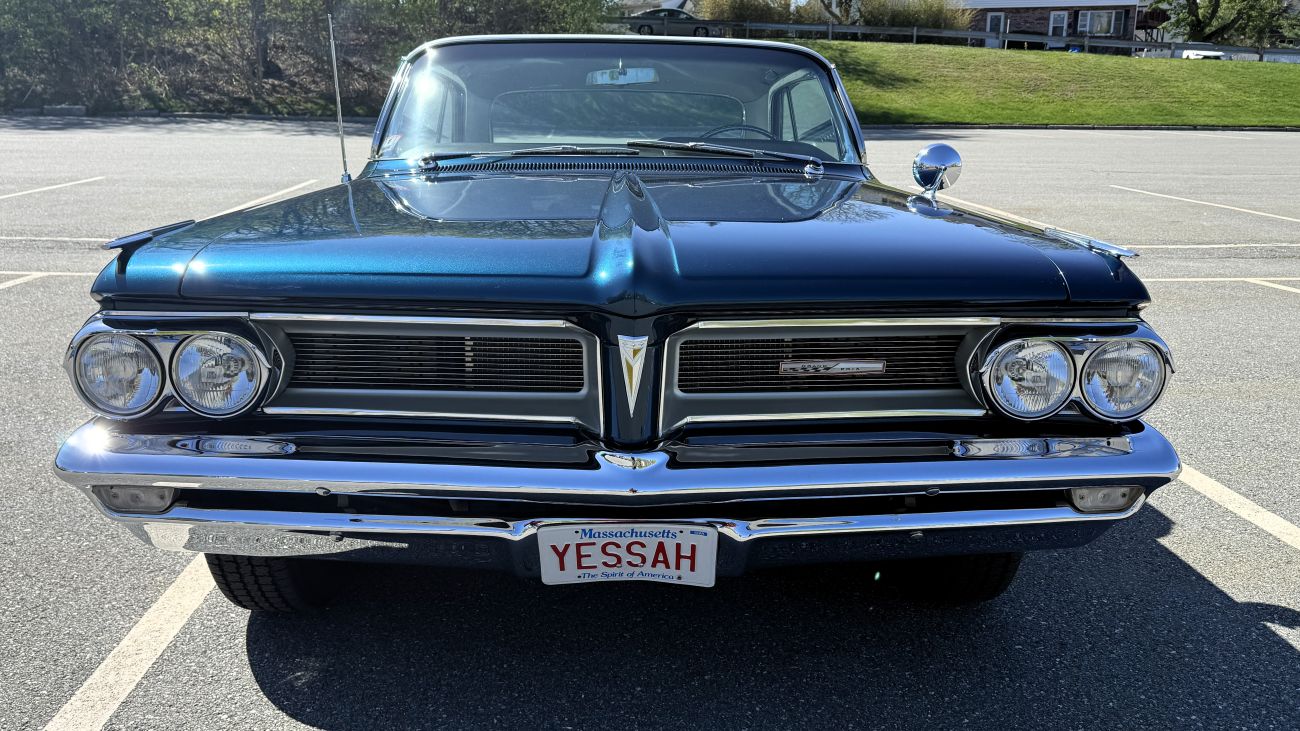
This 1962 Pontiac Grand Prix may have been a response to a young trend, but the model itself sparked a trend because personal luxury cars were usually a step up or two in price. The Grand Prix brought affordable class to the segment, leading to me-too responses from competitive brands such as Oldsmobile, Dodge, and even Buick. The auction for this GP ends on Wednesday, June 18, 2025, at 11:00 a.m. (PDT), so be poised to bid on this classy coupe before you miss out.
Visit the AutoHunter listing for more information and a photo gallery
No matter how expensive, attractive, or lavishly furnished a car may be, when you see too many examples of it out on the road or in parking lots, it starts to feel much less special. Our Pick of the Day, a 1967 Mercedes-Benz 300 SE Cabriolet posted on ClassicCars.com by a dealership in Missouri, is all those things, but it still manages to remain special.
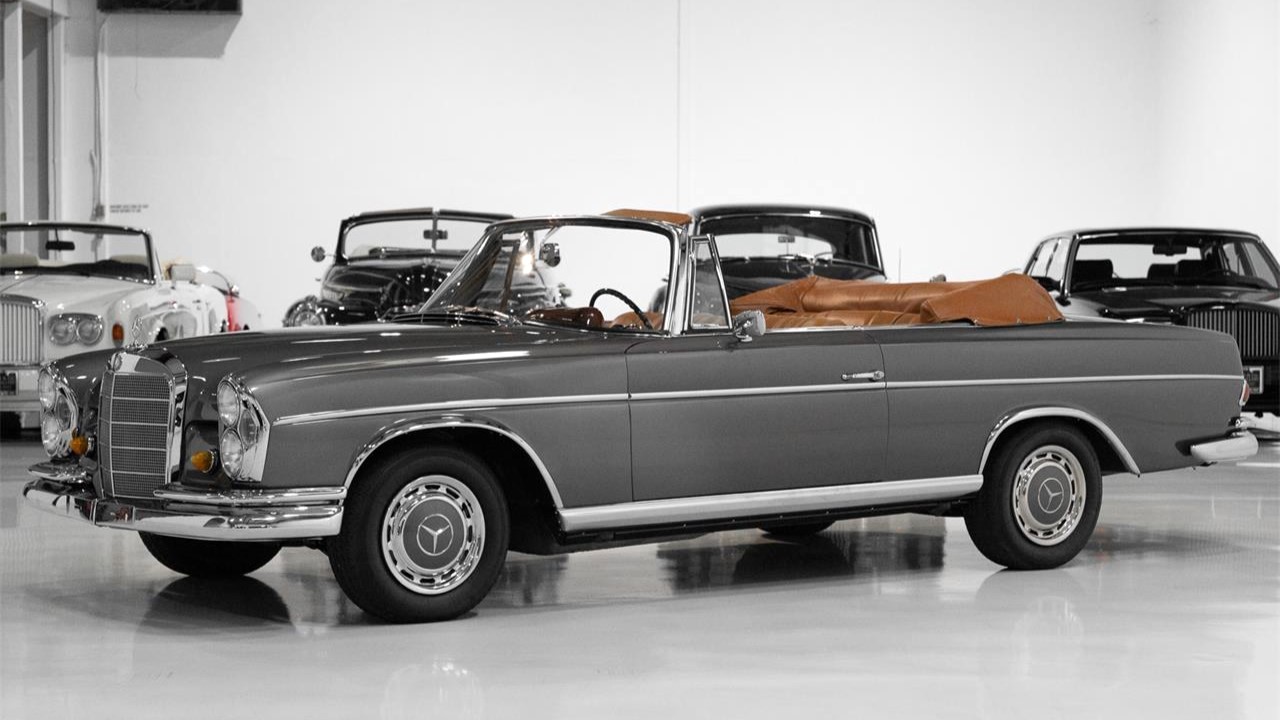
Why? Because there’s a good chance you’ll never see one up close. If you do, there probably won’t be a second time—Mercedes only made 708 300 SE Cabriolets between February 1962 and December 1967. Statistically, a certain percentage of those have likely been lost to accidents, natural disasters, or poor care/negligence. This particular 300 SE cabrio not only avoided such a fate but, thanks to a reportedly $300,000 restoration, it also looks decades younger than its model year indicates.
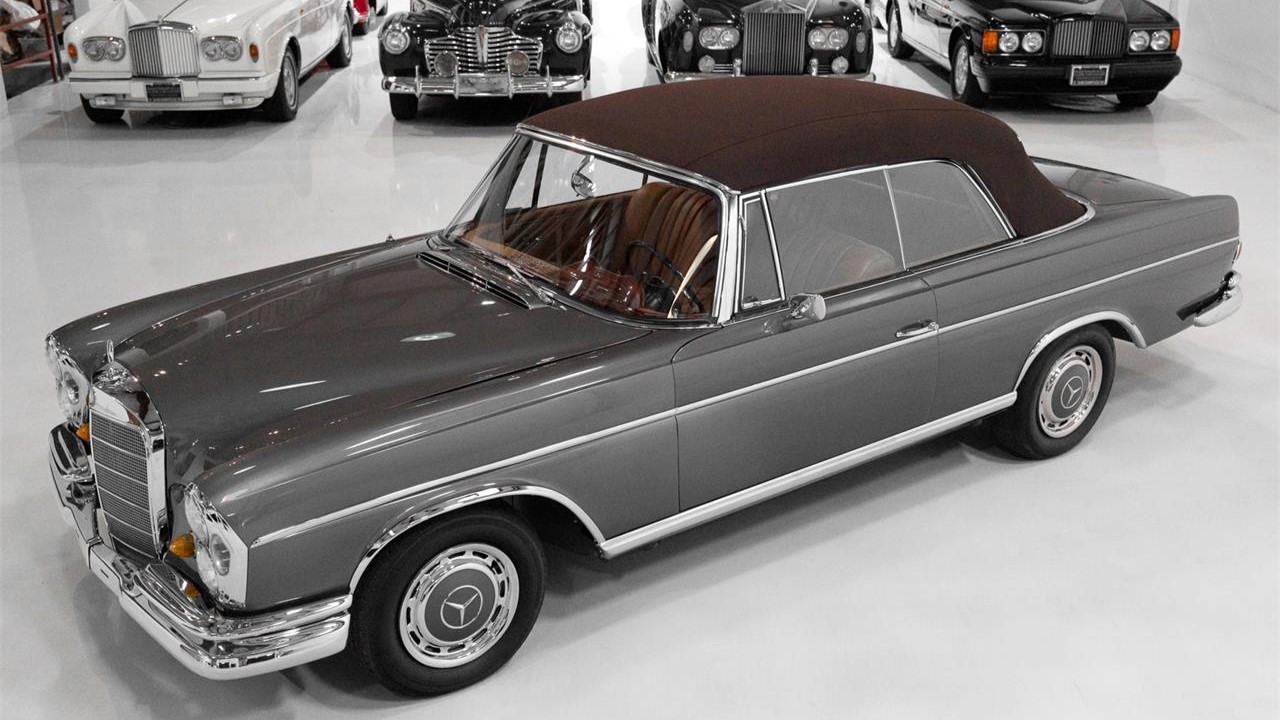
As part of the visual overhaul, the Paul Bracq-designed body was refinished in Anthracite Grey Metallic, which is attractive all by itself and even more handsome under the chocolatey Brown soft top. Those are definitely conservative colors, but the 300 SE’s lines and chrome accents should have no problem turning heads.
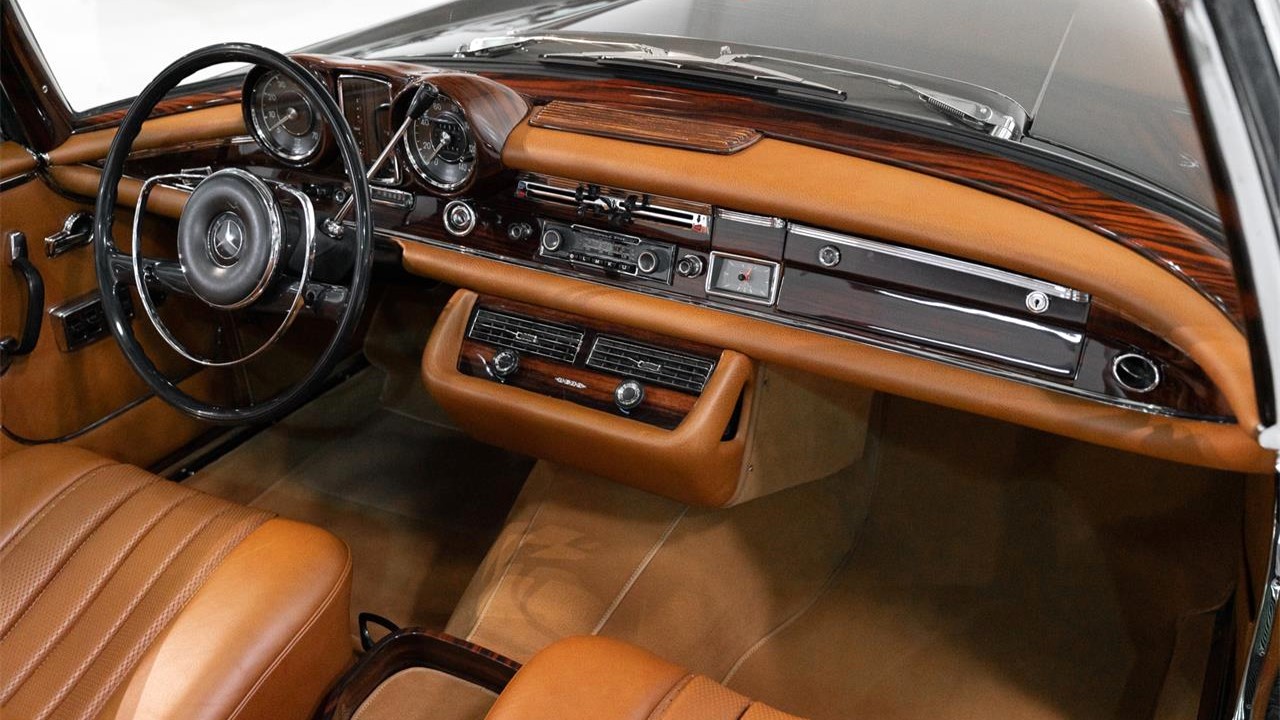
When the top is down, people will definitely be looking to see who’s in this majestic open-air cruiser. As they do, they’ll also get a glimpse of the Cognac leather upholstery and gleaming, vibrant wood trim on the upper and middle sections of the dashboard. Only the driver of this W112 and his/her passengers will get to experience the convenience of its power features, full sound of its Becker Grand Prix AM/FM radio, and comfort of its air suspension.
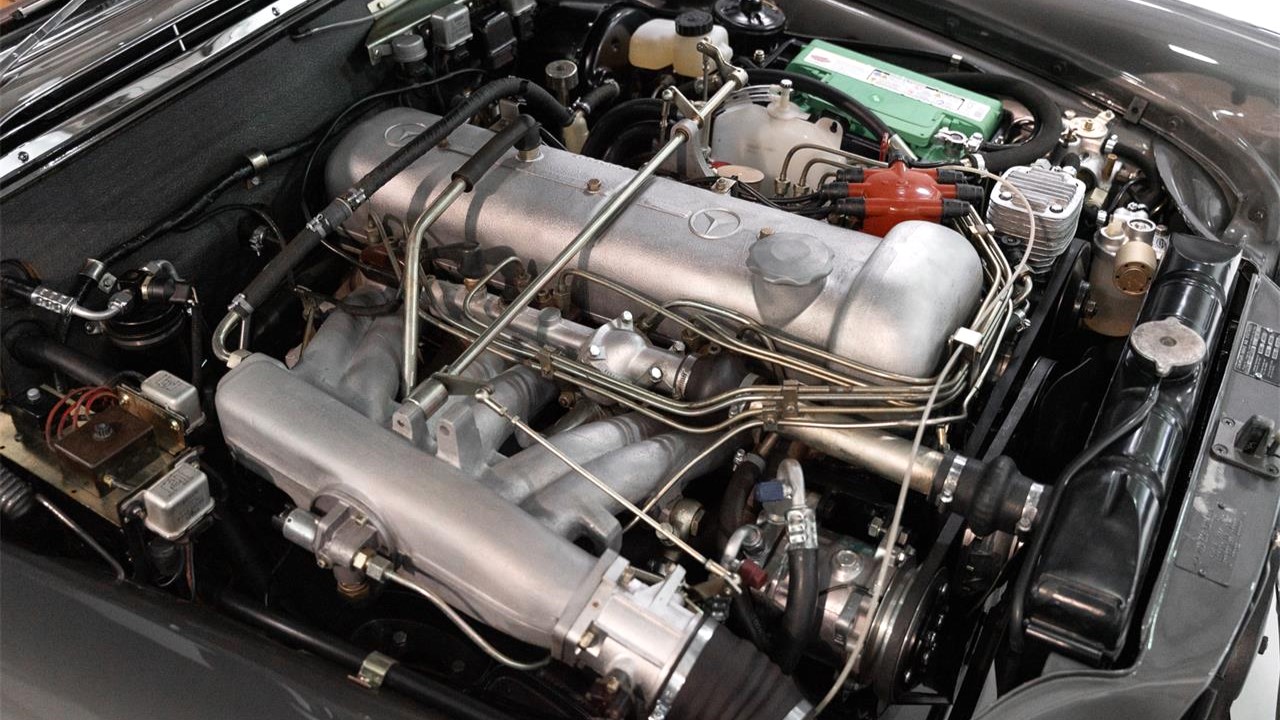
Given that this 300 SE was built after 1964, its M189 (189.987) fuel-injected 3.0-liter I6 benefits from a slight bump in output to 170 horsepower and 183 lb-ft of torque. A four-speed automatic with a column-mounted shifter puts this drop-top into motion and gives people the chance to see a rare sight.
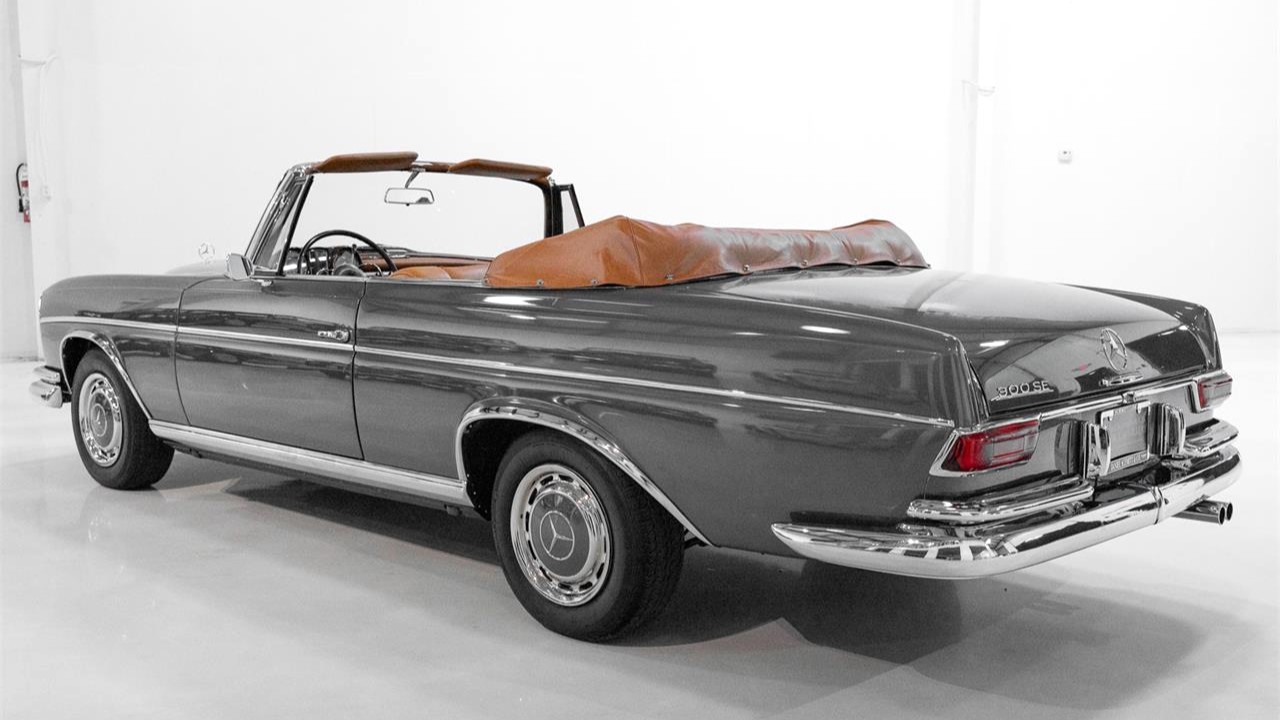
You don’t have to be one of those many—you can be one of the few to own such a low-production vehicle. The price of that privilege—and this 1967 Mercedes-Benz 300 SE Cabriolet—is $269,900.
Click here to view this Pick of the Day on ClassicCars.com
This 1931 Ford Model A is a steel-bodied, five-window coupe that was acquired by the seller’s uncle in mid-1970s, and it sat as an incomplete project from 1993 until it was finished by the seller in 2025 using the collection of parts assembled by his family. The body was mounted on a custom-fabricated ’32 frame, and the top was chopped, the roof was filled with metal, and it was painted matte red. The car rides on drop axle up with a four-bar setup up front and a four-link Ford 9″ rear end, and it has four-wheel disc brakes and 15″ Jegs alloys with staggered tires. Power comes from a 350ci V8 topped by an Edelbrock intake manifold, a Demon carburetor, an intake scoop, an Accel HEI distributor, an aluminum radiator and electric fan, and baffled lake-style headers, and it is linked to a TH350 automatic and a rebuilt limited-slip differential with Strange Engineering axles. Inside are bucket seats, a billet shifter, Stewart-Warner gauges, and a Grant GT wheel. This five-window street rod is now offered at no reserve with service records, spare parts, and a clean Wisconsin title in the seller’s name listing the car as a 1931 Ford.

The steel body has a 4″ chop of the roofline, and the roof was filled and the floors were replaced with sheet metal before it was painted matte red. The seller notes there are rough spots in the fabrication and body work, and there are no turn signals or wipers. A battery disconnect switch is mounted on the right-rear corner, and a ’32 grille was utilized. The bottom of the windshield is scratched.

The car rides on a fabricated ’32 frame with a four-bar front end, a four-link rear end, and unassisted disc brakes both front and rear. The front drop axle has a transverse leaf spring and forged spindles, while coilovers are utilized out back. Staggered tires are mounted on the 15″ Jegs SSR Spike alloys.

Bucket seats mounted on sliders were added along with a billet shifter. The floor is covered in black vinyl, and the headliner is diamond-pattern metal.

A Grant GT wheel and Stewart-Warner gauges were fitted. The ~100 miles on the cluster represents the distance driven since completion of the build.

An aluminum fuel tank and the battery are mounted in the trunk, which has a support strut for the lid.

The 350ci V8 was built and installed in 2025 according to the seller. It is topped by an Edelbrock intake manifold, a Demon carburetor, and an intake scoop, and it has an Accel HEI distributor, an aluminum radiator and electric fan, and lake-style headers with baffles.

The seller reports that the transmission was rebuilt ~five years ago but not used until it was installed. The Ford 9″ axle was sourced from a Lincoln Versailles and narrowed, and the limited-slip differential was rebuilt and Strange Engineering axles were fitted.

The car is titled as a 1931 Ford using VIN A4446627.

Records from the build are displayed in the gallery.
This 1956 Chevrolet 3100 roadster pickup was built by Scott’s Hotrods of Knoxville, Tennessee, and featured in a 2004 episode of TLC’s show Rides. Dubbed “Heavy Metal” in homage to its all-steel bodywork, the truck is powered by a supercharged 5.7-liter LS1 V8 backed by a 700R4 four-speed automatic transmission and a Speedway Engineering quick-change rear end. It rides on a reinforced and boxed frame with a SuperSlam independent front assembly, a four-link rear setup with a Panhard bar, Air Ride Technologies air springs, rack-and-pinion steering, Wilwood discs, and Colorado Custom 18” and 20” wheels. Additional highlights include a unitary cab and cargo bed with a shaved exterior, a chopped windshield, and flush-mounted lighting as well as leather and alligator skin upholstery, a billet steering wheel, and Classic Instruments gauges. After the initial build was completed, the truck was unveiled at the Detroit Autorama, featured in Motor Trend and Custom Classic Trucks, and displayed at SEMA in 2006. An ARC audio system was later added to the cargo bed, and work performed since the seller’s acquisition in 2024 has involved overhauling the suspension, refreshing the upholstery, installing an Alpine head unit, and replacing the starter and spark plugs. “Heavy Metal” is now offered with a DVD set, trophies, a display board, and a clean Texas title in the seller’s name.

Modifications to the steel body started with removing the cab roof and door window frames. A front valance was joined to the reshaped fenders, the cowl was filled, and the windshield frame was chopped, while a tubular support structure was fabricated to support the cargo bed, which was integrated with the back of the cab. The rear fenders were widened and merged with the side steps and rear roll pan.

After the bodywork was completed, Ferrari Rosso Corsa DuPont paint and clearcoat were applied, per the seller. Key design elements include headlights sourced from a Mercedes-Benz, polished grille bars, flush-mounted LED taillights, and dual exhaust outlets that pass through the rear corners. The seller notes hairline cracks in the paint and touched-up chips that are shown up close in the gallery.

Tubular crossmembers were welded onto the boxed frame rails, and the rear section was arced to accommodate the rear axle. A Scott’s SuperSlam independent front assembly and four-link rear setup were also added along with a Panhard bar. The upper and lower ball joints, spindles, and suspension bushings were replaced in December 2024, and the Air Ride Technologies air suspension was refreshed.

Colorado Custom 18×8” front and 20×12” rear wheels are wrapped in Nitto tires with redline sidewall accents. The truck is equipped with power-assisted rack-and-pinion steering, and polished Wilwood calipers are matched with drilled and slotted rotors measuring 13” up front and 12” out back.

Jessie’s Upholstery in Ventura, California, trimmed the interior in beige leather, alligator skin, and bound wool carpets. A waterfall center console houses control panels for the air suspension as well as a display screen connected to a DVD player mounted under the passenger seat. The alligator accents were re-dyed under current ownership, and a Bluetooth-capable Alpine head unit was installed. American Autowire supplied the truck’s wiring.

The Colorado Custom steering wheel is mounted to an Ididit tilt column with Borgeson U-joints, and a Classic Instruments 120-mph speedometer and a combination gauge are mounted ahead of the driver. The six-digit odometer shows 1,500 miles, approximately 300 of which have been added under current ownership.

The upholstery scheme carries over the cargo bed, which houses ARC Audio amplifiers and subwoofers within custom enclosures. The rear wheel wells were tubbed during the build.

The 5.7-liter GM Performance LS1 V8 is equipped with a polished Magnuson supercharger, a Superchips ECU, and Rewarder headers that flow into a stainless-steel dual exhaust system with a crossover pipe and Flowmaster mufflers. Body-color ignition coil covers have been added, and the radiator is cooled by a SPAL electric fan. The starter, spark plugs, ignition wires, and oil were replaced under current ownership. A prop is required to hold up the hood.

Power is sent to the rear wheels through a Bowler Performance 700R4 four-speed automatic transmission and a Speedway Engineering Super Max quick-change rear end. Scrapes are noted on the undersides.

The car is titled as a 1956 Chevrolet using the Arizona Assigned VIN AZ375024.

A collection of trophies will accompany the truck along with a Rides DVD set and other items that are shown in the gallery.
This Ford roadster hot rod was built over the course of six years using a Brookville steel body mounted to a C-channel frame. Power comes from a ’48 Mercury 239ci flathead V8 with an ISKY camshaft, Edelbrock cylinder heads, dual Stromberg carburetors, and custom-fabricated headers, and the engine is linked to a ’39 Mercury three-speed manual transmission, a Mitchell overdrive unit, and a Halibrand quick-change rear end. The car rides on a 4”-drop front axle with polished hairpin radius rods, and other highlights include gray upholstery, Stewart-Warner gauges, steel wheels, and ’48 drum brakes. Initially finished in black with yellow scallops, the car was displayed at the 2015 Grand National Roadster Show and later revised with its current all-black paint. This Highboy roadster was acquired by the current owner in 2022, and it is now offered with a clean Arizona title in the seller’s name listing it as a 1930 Ford.

The Brookville steel body is mounted to a C-channel frame, and both are finished in black. Details include a ’32 grille shell, a louvered hood, a tilt-out windshield, a black soft top, round side mirrors, and a polished front spreader bar, grille insert, and tubular rear bumper. Paint chips are noted by the seller.

Gray-finished steel wheels wear polished hubcaps with Ford script highlighted in red, and they are wrapped in big-and-little pie-crust tires. The car rides on transverse leaf springs, and the front setup incorporates a 4”-drop front axle, polished hairpin radius rods, and a Franklin steering box with a drag link. Braking is handled by ’48 Ford drums at all four corners.

The cabin features a Glide bench seat trimmed in gray upholstery that extends to the door panels. Color-coordinated carpets and lap belts have also been installed along with a double-bend shifter and a Sears heater box.

The four-spoke steering wheel sits ahead of Stewart-Warner instrumentation consisting of a 160-mph speedometer and auxiliary gauges. The five-digit odometer shows 5,200 miles, approximately 4,500 of which have been added under current ownership.

The ’48 Mercury 239ci flathead V8 is equipped with an ISKY camshaft, Edelbrock cylinder heads, dual Stromberg carburetors, Mallory ignition components, and custom-fabricated headers that flow into a dual exhaust system with capped cutouts. The most recent oil change was performed in March 2024.

Power is sent to the rear wheels through a ’39 Mercury three-speed manual transmission with a Mitchell overdrive unit and a Halibrand quick-change rear end.

The car is titled as a 1930 Ford using the VIN A3072774. The current Arizona title carries a Not Actual Mileage notation.

Photos taken after the build was initially completed are provided in the gallery, and the seller notes it has been awarded two first-place trophies in local shows.
The compact car market has long been a proving ground for automotive innovation, delivering memorable hits and equally unforgettable misses.
While some models set benchmarks for value and ingenuity, others became cautionary tales—let down by underwhelming performance, awkward design, or persistent reliability issues.
In this article, we shine a light on ten compact cars that missed the mark, not for lack of ambition, but for their inability to deliver where it truly mattered.
These vehicles remain memorable, but unfortunately, it’s for all the wrong reasons.
The 1980s marked a pivotal era for Subaru, as the brand carved out a unique space in an increasingly crowded automotive world. Known for its unconventional engineering and steadfast reliability, Subaru began to capture the imagination of drivers seeking something different. The introduction and refinement of all-wheel-drive technology set Subaru apart, appealing to those who valued safety and versatility. Amid fierce competition from established giants, Subaru’s blend of innovation and practicality helped lay the foundation for its enduring reputation. This decade was truly the beginning of Subaru’s rise to global recognition.
The 1980s marked a defining era for Subaru, propelling the brand from a quirky niche player to a true innovator in the automotive world.
Known for their practical engineering, Subaru vehicles stood out with their unique blend of ruggedness and reliability.
This was the decade Subaru introduced and perfected its legendary all-wheel-drive technology, forever changing the expectations for compact cars and wagons.
By embracing versatility and durability, Subaru cemented its reputation as the go-to brand for drivers seeking adventure and dependability.
Let’s explore ten standout models that made the 1980s Subaru’s decade of transformation.
Gone are the days when four-cylinder engines were seen as the underdogs of the automotive world.
Thanks to advanced turbocharging technology, these compact powerplants now deliver levels of performance that once belonged solely to V6s and V8s.
Today’s turbocharged four-cylinders offer blistering acceleration, razor-sharp responsiveness, and surprising efficiency—all in a lightweight package.
This evolution has sparked a new wave of high-performance vehicles that excite enthusiasts and rival much larger engines for sheer thrill.
Let’s dive into 15 modern four-cylinder rockets that prove just how far turbo power has come.
